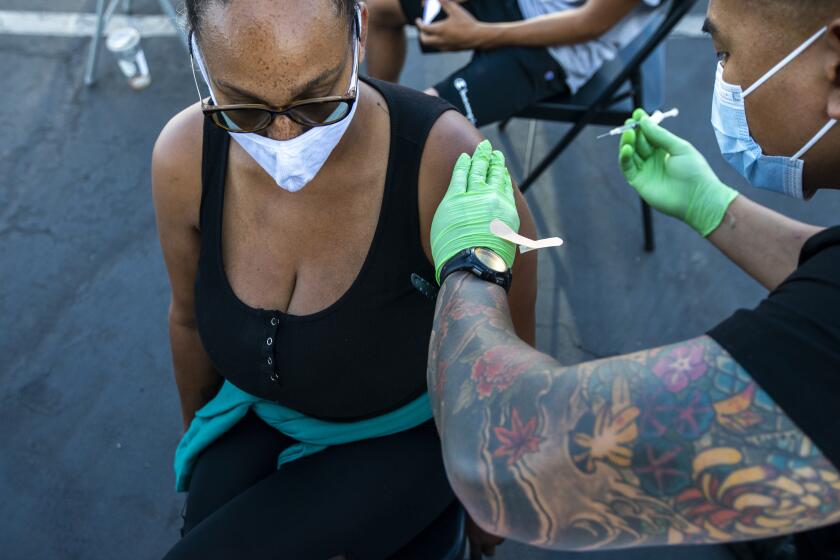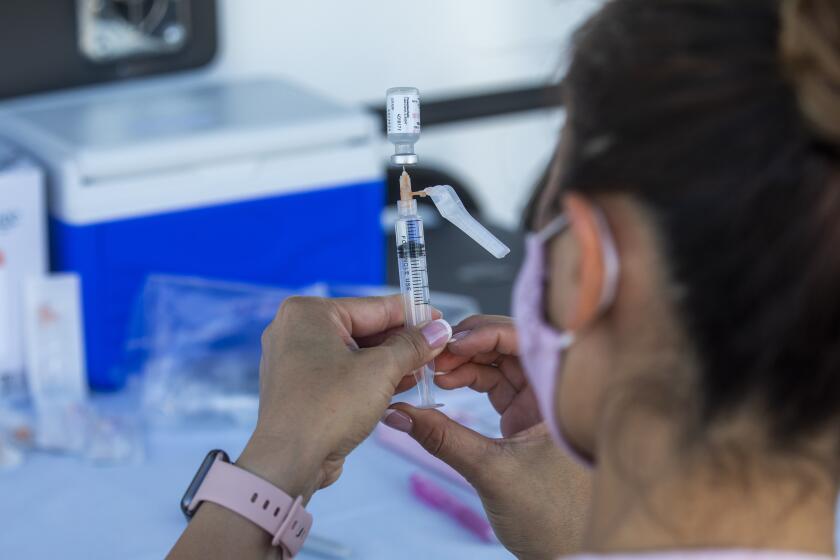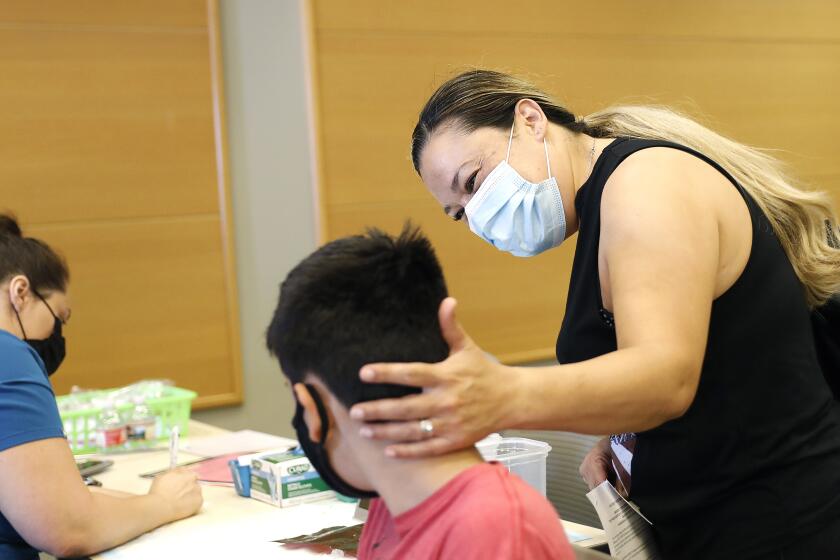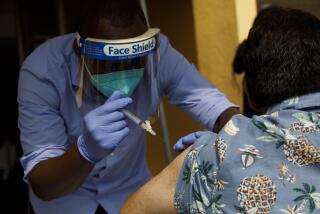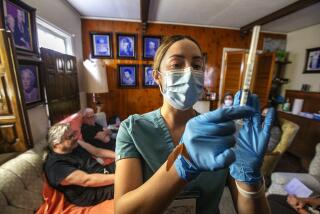No time or ‘enormously selfish’? People who haven’t gotten a COVID-19 shot may have many reasons

- Share via
With new coronavirus cases rising by more than 1,000 each of the last five days, some Los Angeles County leaders are not mincing words about the need for people to get vaccinated.
Health officials have said upward of 99% of the new infections being confirmed countywide involve those who have not been inoculated against COVID-19 — a clear challenge and source of frustration given the pandemic’s continued potency.
“It just strikes me as enormously selfish,” county Supervisor Sheila Kuehl said Tuesday. “We can’t rely on herd immunity if the herd won’t get their shots.”
But while there are undoubtedly those who fundamentally reject rolling up their sleeves, officials note there are many reasons why people may not yet have gotten vaccinated.
Tuesday marked the fifth straight day that the number of new coronavirus infections exceeded 1,000.
Some remain concerned about potential health effects, despite assurances that the shots are safe. Others simply have been too tied up with responsibilities at work or home to make the time.
Children under 12 also aren’t yet eligible to be inoculated against COVID-19.
The wide array of reasons underscores the magnitude of the challenge facing health officials in their quest to achieve herd immunity.
Here is what we know:
How many people in L.A. County have been vaccinated?
Data compiled by The Times show that roughly 52% of all Angelenos are fully vaccinated. However, millions of people still aren’t.
That, officials say, leaves a huge number of people who are still vulnerable to infection and illness. Some communities where vaccinations have been low have been particularly hard hit by the recent increases in cases.
Door-to-door outreach and vaccine requirements at work would help curb coronavirus spread, experts say.
What are some tactics officials hope to use?
Some public health experts have said effective approaches for persuading people to get vaccinated include answering questions and making the vaccine even more available to those who may not have prioritized getting the shot, either because they don’t think COVID-19 is a threat to them or because of swirling misinformation surrounding the shots.
Experts say only a small fraction of residents are adamantly opposed to vaccinations. Quite a few who haven’t been vaccinated simply need more information about why getting the shot is still important, they say.
“Relationships really matter,” said Dr. Christina Ghaly, L.A. County’s director of health services. Giving people “an opportunity to ask their questions, to get fact-based information about the vaccine, to be given a chance to just talk through their concerns” is an effective approach, she added.
“One-on-one conversations — it’s very labor intensive, not always very fast, it takes time. But that’s been the best thing that has really helped,” she said.
Mobile vaccination units are another approach that can tear down any practical barriers to access. During a visit to Pomona over the weekend, more than 300 people were vaccinated at a swap meet.
Some of the people who got vaccinated there “just really had a different idea about what the vaccine was about,” Supervisor Hilda Solis said.
The tally marks the fourth consecutive day that new cases totaled more than 1,000, health officials said.
What about mandatory vaccinations?
Another strategy could involve new requirements to get vaccinated, such as at workplaces, according to UC San Francisco epidemiologist Dr. Kirsten Bibbins-Domingo.
Short of that, she said, employers could require unvaccinated workers to get tested daily — an approach that has been used elsewhere.
“When being vaccinated becomes the more convenient of the two options, that will drive people to be vaccinated,” she said. “You have to make it slightly less convenient to be unvaccinated at this point.”
“If you choose to get tested every day, because you don’t believe in vaccination, that might be fine. But I think for some, being tested every day or being tested at some very regular interval might be that the thing that says: ‘Well, yeah, when I look at the risk and benefits, the vaccine is looking a little bit better.’”
San Francisco has been a leader in imposing vaccination requirements for certain workers.
Already, San Francisco has ordered all workers in “high-risk settings,” such as hospitals, nursing homes and residential facilities for older people, homeless shelters and jails, to be fully vaccinated by Sept. 15. An exemption will be available for workers with valid religious and medical reasons, and they will be required to get tested for the coronavirus weekly.
San Francisco has also ordered all 35,000 of its city workers — including police, firefighters, custodians and clerks — to get vaccinated or risk losing their jobs, unless they have a religious or medical exemption, once a vaccine has been formally approved by the U.S. Food and Drug Administration. Currently, all three available vaccines are being distributed under an emergency use authorization.
The University of California and California State University systems have also announced they will eventually require COVID-19 vaccinations for all students, faculty and staff on campus properties. Dozens of colleges nationwide have said they’ll require vaccination for enrollment in the fall, including Yale, Princeton and Columbia.
Unvaccinated people, perhaps hoping they might outlast the pandemic without getting a shot or getting sick, may be playing an increasingly risky game of chance.
Are there some success stories?
San Francisco’s outreach to the hard-hit Latino community in particular has been a model, with 72% of Latino residents having received at least one dose — a rate even better than white residents, 65% of whom are at least partially vaccinated. In much of the U.S., the vaccination rate for Latinos lags behind white residents.
There have been teams that go out to places like San Francisco’s Tenderloin District, where they interact with people on the streets, in stores and churches to promote vaccinations and administer the shots.
And that kind of interaction can make the difference: Some people can work long hours, and having vaccination advocates make their pitch and answer questions causes someone to finally decide to take the shot, Bibbins-Domingo said.
It’s also important that the people delivering the messages and shots are well trusted in the community.
“It is the linking to the conversation to the actual getting of the shot — and getting the shot from somebody you know and trust — that are the one-two punch to get the job done. And it has been working,” Bibbins-Domingo said.
“It’s just a slow strategy,” she added. But “there are no shortcuts. We have to double down on doing this again — especially for people for whom there are some barriers, whether it is just having the conversation or mistrust.”
In the Central Valley, UC Merced Community and Labor Center Executive Director Ana Padilla said there still needs to be better access to the vaccine — and good information about it — for people like agricultural workers, who are now working the busiest time of the year. She suggested that there be a greater effort to link trusted community-based groups to administer vaccines near work sites, which will be better equipped to answer questions from workers.
“If you work 8 to 8 — every single day of the week — so that you have enough money to get through those hard winter months, you don’t have the options [to seek vaccinations] that other folks might believe that you have,” Padilla said.
L.A. County is taking a similar approach in focusing vaccination clinics in hard-hit areas. But L.A. County has a far more vast challenge — it’s the nation’s most populous, and blanketing the region with intense outreach efforts might be more difficult here.
The county is also pursuing a strategy of attempting to vaccinate close contacts of COVID-19 cases, Health Officer Dr. Muntu Davis said Tuesday.
“Once the contacts are identified during the case investigation process, a member of our team reaches out to their contacts to do contact tracing, provide information, as well as to offer them a home visit by a nurse who can vaccinate on site at the contacts’ residence,” he said.
The pilot launched Friday in East L.A., Davis said, and could be expanded if it proves effective.
More to Read
Sign up for Essential California
The most important California stories and recommendations in your inbox every morning.
You may occasionally receive promotional content from the Los Angeles Times.
